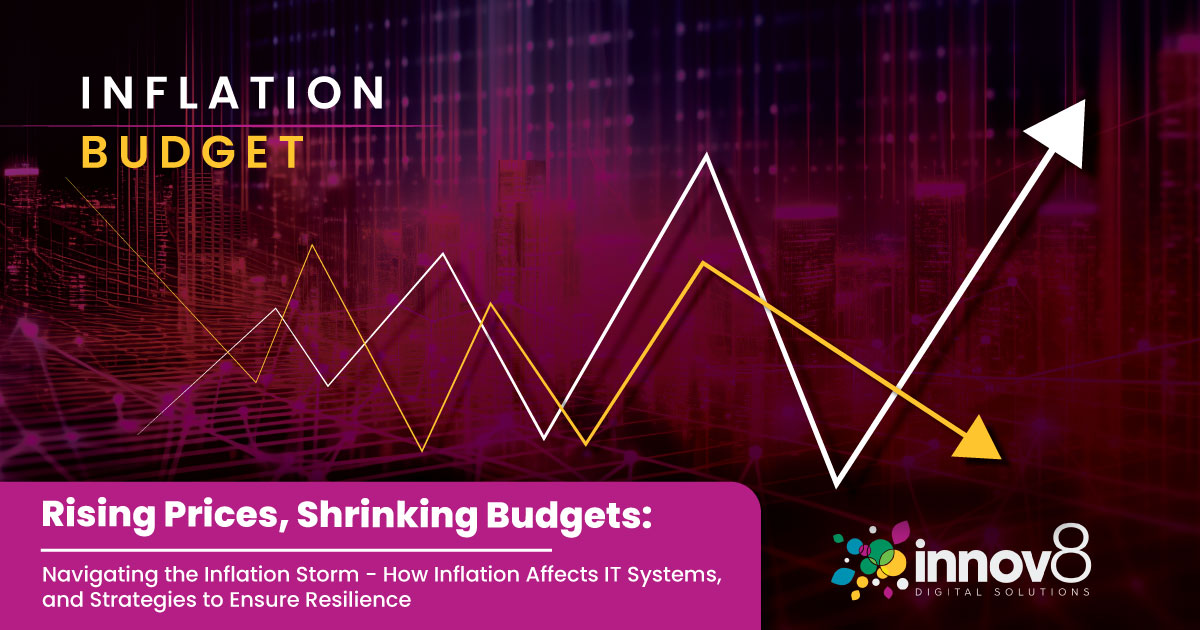In the intricate landscape of technological management, the challenges posed by inflation are akin to navigating uncharted waters. As prices surge and budgets face unprecedented constraints, organizations find themselves struggling in the formidable economic storm known as inflation.
Inflation, defined as the general increase in prices and the fall in the value of money, is a multifaceted economic phenomenon. Various factors, including supply chain disruptions, increased demand, geopolitical tensions, and, at times, government policies influence it.
In recent times, the global economy has witnessed a confluence of these factors, creating an inflationary storm that's affecting businesses across sectors. Professionals at Innov8 share some insights into the often-overlooked but crucial relationship between inflation and its multifaceted impacts on technology budgets, procurement, maintenance, and overall IT strategies.

The Ripple Effect: Unraveling the Impact of Inflation on IT Systems
In the realm of Information Technology (IT), the impact of inflation is both subtle and profound. As prices rise and the value of money declines, IT systems grapple with a unique set of challenges that can influence their efficiency, maintenance, and strategic planning.
Hardware & Software Costs
The first and most direct impact of inflation on IT systems is seen in the costs of hardware and software. As the prices of components, devices, and licenses increase, organizations may find it more challenging to maintain or upgrade their IT infrastructure.
This can result in delayed technology refresh cycles and may lead to the utilization of outdated systems, compromising security and performance. However, with Innov8’s managed IT services and rental solutions, you can keep your organization up and running with success in this digital era without breaking the bank.
Call 1-800-663-3923 to find top-notch solutions, including office copy machines for sale, commercial copy machines for sale, commercial printers for sale, large format printers for sale, lease office copy equipment, commercial laser printers for sale, refurbished copier machines, Canon office printers for sale, and other managed print and IT solutions.
Operational Expenses
Beyond the initial investment in hardware and software, operational expenses related to IT also experience an inflationary pinch.
Costs associated with energy consumption, maintenance contracts, and cloud services can escalate, straining the budgets allocated for IT operations.
Organizations are compelled to revisit their expenditure models, optimize resource utilization, and explore cost-effective alternatives to cope with rising operational expenses.
Talent Acquisition & Retention
Inflation not only impacts the costs of physical assets but extends to human resources as well. The demand for skilled IT professionals often outpaces supply, leading to increased competition and, consequently, higher salaries.
Organizations find themselves in a predicament where attracting and retaining top IT talent becomes a costly affair. This, in turn, influences overall IT project costs and the ability to execute strategic initiatives.

Project Budgets & Timelines
Inflationary pressures can disrupt the carefully crafted budgets and timelines of IT projects. Unexpected increases in costs can lead to budget overruns, impacting the financial health of projects and organizations. Additionally, the time-sensitive nature of many IT projects may be compromised as delays caused by budgetary constraints become inevitable.
Vendor Relationships
IT systems often rely on external vendors for hardware, software, and support services. In an inflationary environment, these relationships can be strained as vendors may seek to adjust prices or modify contract terms.
Organizations must engage in proactive negotiations and vendor management to ensure that the quality and scope of services are maintained while navigating through cost fluctuations. Companies like Innov8 offer consultations where businesses can get personalized solutions tailored according to their needs. This helps ensure efficiency while saving costs in the long run. Scalability is also possible when you partner with a reliable vendor dedicated to helping your business succeed amid the overcrowded space.
Investment in Innovation
Inflation can force organizations to reevaluate their priorities, potentially limiting investment in innovative IT solutions. Projects that contribute to long-term strategic goals and technological advancements may be deprioritized in favour of more immediate, cost-sensitive concerns. This can impact the overall competitiveness of organizations in the rapidly evolving technological landscape.
Cybersecurity Challenges
The field of cybersecurity is not immune to the effects of inflation. As the value of assets rises, the incentive for cybercriminals to exploit vulnerabilities also increases. Organizations may find it challenging to allocate sufficient resources to maintain robust cybersecurity measures, putting sensitive data at risk.
Legacy System Dilemma
In an effort to mitigate costs during inflationary periods, organizations might extend the lifespan of legacy IT systems. While this might offer short-term financial relief, it comes at the expense of system performance, security, and compatibility with modern technologies. Ultimately, the reluctance to invest in up-to-date IT infrastructure may hinder organizational growth and resilience.
Strategic Planning & Risk Mitigation
Inflation introduces an element of uncertainty into strategic IT planning. Organizations must incorporate economic forecasts, inflation rates, and associated risks into their long-term IT strategies. This necessitates a more dynamic and adaptive approach to planning, with a focus on risk mitigation and contingency measures.
Global Supply Chain Impact
The interconnectedness of the global economy exposes IT systems to the ripple effects of inflation across borders. Disruptions in the supply chain, whether due to inflation-driven price increases or geopolitical factors, can lead to shortages of critical IT components. Organizations must diversify their supply chain sources and build resilience to withstand external shocks.
Strategies for Resilience

Prioritize Critical Initiatives
Identify and prioritize projects that directly contribute to the organization's core objectives. Focus on initiatives that enhance operational efficiency, reduce costs, or directly impact revenue generation. This ensures that limited resources are allocated to projects with the highest strategic importance.
Cost Optimization & Efficiency Measures
Conduct a thorough review of existing IT processes and identify areas for cost optimization. Streamline workflows, eliminate redundancies, and automate routine tasks to enhance operational efficiency. Implementing lean methodologies ensures that resources are used judiciously, maximizing output while minimizing costs.
Cloud Migration & Optimization
Embrace cloud computing to achieve scalability, flexibility, and cost-effectiveness. Cloud services allow IT organizations to scale resources based on demand, reducing the need for extensive capital expenditures. Regularly optimize cloud usage to ensure cost-efficiency and align resources with actual requirements.
Vendor Management & Negotiations
Collaborate closely with technology vendors to negotiate favourable terms, including extended payment terms or bulk purchase discounts. Establish strategic partnerships that go beyond transactional relationships. Vendor consolidation may also be considered to enhance negotiation power and simplify procurement processes.
Strategic Outsourcing
Evaluate which IT functions can be outsourced to specialized service providers. Strategic outsourcing can provide cost savings, access to specific skills, and flexibility in scaling operations. Outsourcing non-core functions allows internal teams to focus on high-value, strategic activities.

Remote Work Policies
Embrace flexible work policies, including remote work options. Reducing the need for on-site operations can result in cost savings related to office space, utilities, and other associated expenses. Remote work policies also enable access to a broader talent pool and promote workforce flexibility.
Collaboration Tools & Remote Work Technologies
Leverage collaboration tools and technologies that facilitate remote work. This not only aligns with evolving work trends but also reduces the need for extensive physical office infrastructure. Embracing remote work can lead to cost savings in terms of office space, utilities, and related facilities.
Investment in Automation & AI
Leverage automation technologies and artificial intelligence (AI) to streamline routine tasks, enhance efficiency, and reduce reliance on manual labor. Automated processes can optimize workflows, minimize errors, and free up resources for more strategic tasks.
Cybersecurity Optimization
Cybersecurity is non-negotiable, but costs associated with robust security measures can strain budgets. Implement a risk-based approach to cybersecurity that prioritizes protection based on critical assets. Invest in threat intelligence to stay ahead of emerging risks and prioritize cybersecurity initiatives that provide the highest return on investment.
Data Governance & Analytics
Leverage data as a strategic asset by implementing robust data governance practices. Implement advanced analytics and business intelligence tools to derive actionable insights from data. Informed decision-making based on data analytics can lead to more efficient resource allocation and strategic investments regarding resource allocation, project prioritization, and overall strategy. Utilize analytics to identify areas for improvement and optimize IT operations.
Agile and Adaptive Governance
Adopt agile governance frameworks that enable rapid adaptation to changing circumstances. Establish cross-functional teams that can pivot quickly in response to evolving priorities. Embrace agile methodologies not only in development but also in project management and overall IT governance.
Continual Service Improvement (CSI)
Implement Continual Service Improvement as a fundamental component of IT Service Management. Regularly assess and reassess IT services, processes, and performance. A culture of continual improvement ensures that IT organizations remain agile, responsive, and capable of evolving with changing circumstances.
Continuous Employee Development
Invest in the continuous development of the IT workforce. Upskilling and reskilling initiatives ensure that employees stay current with evolving technologies and industry best practices. A skilled and adaptable workforce contributes to organizational resilience.

Open Communication Channels
Foster open communication channels between IT and other business units. Transparent communication about budget constraints, project timelines, and the impact of IT decisions on broader organizational goals enhances understanding and collaboration. This collaboration ensures that IT initiatives are closely tied to business priorities.
Scenario Planning & Risk Management
Develop scenario-based strategies that account for various economic scenarios, including different levels of inflation. Conduct risk assessments regularly to identify potential challenges and devise contingency plans. Preparedness is key to navigating uncertainties effectively.
Legacy Systems Modernization
Legacy systems often incur higher maintenance costs and can impede agility. Develop a phased plan for the modernization of legacy systems, focusing on those that contribute the most to organizational objectives. Consider leveraging modernization technologies, such as containerization and microservices, to enhance scalability and reduce maintenance overhead.
Asset Lifecycle Management
Implement a comprehensive IT asset lifecycle management strategy. This includes planning for the acquisition, utilization, and disposal of IT assets. Optimizing the lifecycle of IT assets ensures that organizations get the most value from their investments and reduces the likelihood of unexpected expenses associated with outdated equipment.
Green IT Practices
Evaluate the energy consumption of IT infrastructure. Energy costs can be a substantial portion of IT budgets. Implement energy-efficient practices, such as server virtualization, optimizing data center cooling systems, and adopting energy-efficient hardware. These measures not only contribute to cost savings but also align with sustainability goals.
Open Source & Free Software Adoption
Explore the adoption of open-source software and free alternatives where feasible. Open-source solutions often provide robust functionality without the licensing costs associated with proprietary software. Embracing a mix of open-source and proprietary solutions allows IT organizations to balance functionality with budget constraints.
Government & Industry Grants
Investigate government or industry-specific grants that support IT initiatives. Many jurisdictions offer grants to encourage technology adoption, especially in areas such as cybersecurity, innovation, and sustainability. Taking advantage of available grants can provide additional financial support for critical IT projects.
Flexible Financing Models
Explore flexible financing models for technology investments. Consider options such as leasing, subscription-based services, or as-a-service models. These models provide flexibility in budgeting and allow organizations to adapt to changing financial conditions.

Scenario Planning & Contingency Preparedness
Develop scenario-based strategies that anticipate various economic scenarios. Implement contingency plans for scenarios such as fluctuating exchange rates, supply chain disruptions, or unexpected inflation spikes. Being prepared for different eventualities ensures a more agile and resilient response.
Cross-Functional Collaboration
Foster collaboration between IT and other business units. Ensure that IT strategies align with broader organizational goals. Collaborate on cost-saving initiatives and jointly assess the impact of IT decisions on the organization's overall financial health.
Innov8, a leading digital solutions provider, offers comprehensive managed IT services tailored to empower businesses in the British Columbia region to navigate the complexities of the digital landscape with confidence and efficiency.
With a holistic approach to resilience, their managed IT services encompass advanced security protocols and real-time monitoring capabilities, fostering organizational efficiency and productivity.
From managed IT services to an array of integrated solutions, including managed print services, Innov8 caters to diverse business needs, facilitating seamless digital transformation despite rising inflation and other uncertainties surrounding IT.
Let Innov8 streamline your business operations with their cutting-edge products and solutions. Contact them today for a free consultation and fortify your digital infrastructure against various evolving threats, including inflation, cybersecurity, technology development, the need for efficiency, and more.


